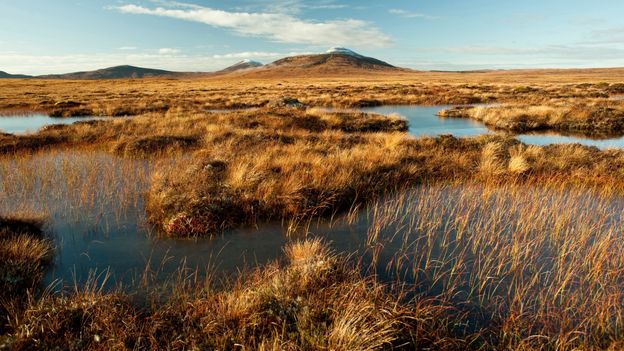One of the last wild places in Britain
Last year, during the height of summer, I stood atop a grassy knoll looking out over a sweep of alien landscape. Set against a gunmetal-grey sky, a rich autumnal carpet was draped over valleys and mountains alike, giving the distant mountain summits of Ben Loyal and Morven a softness as the clouds gathered at their nape. A deep inky pool called a dubh lochan, meaning “black water” in Scottish Gaelic, rippled in the morning light, reflecting the moodiness of the passing sky.
I was in Flow Country: the wild heartland of Scotland. Its name stems from the Old Norse floi, meaning “wet marshy ground”, and the area extends in a broad sweep from the mountainous ranges of the North-West Highlands towards the eastern coastline of the Moray Firth, covering 200,000 hectares between the counties of Caithness and Sunderland.
Flow Country stretches across Caithness and Sutherland in the far north of Scotland (Credit: Eleanor Bentall)
Already a week into my stay, I was volunteering for the Royal Society for the Protection of Birds (RSPB), helping the team with land conservation. The Flow Country is Europe’s largest blanket bog, a type of wetland formed from peat, and one of Scotland’s most valuable environmental assets. Almost 150,000 hectares is designated as a Site of Special Scientific Interest (SSSI), with the RSPB Forsinard Flows reserve caring for 21,000 hectares of it.
“If you’ve got any interest in climate change, restoring and protecting peatland should be very close to the top of your list,” said Joe Perry, coordinator of the Flow Country’s recent bid for Unesco World Heritage Site status. If the bid is successful, the area will gain international recognition for its environmental value. He explained, “It’s a habitat that is really underrepresented.”
It is not hard to see why. A “bog” doesn’t necessarily fit the visual narrative of, say, the Grand Canyon or the Great Barrier Reef. There is no “charismatic megafauna,” as Perry put it. Instead, “It’s about everything you can’t see; what’s underneath the surface.”
Curlew populations have seen their numbers drop steeply in Scotland in recent years (Credit: Andy Hay)
Blanket bogs began forming in northern Scotland at the end of the last Ice Age, around 10,000 years ago. Peat is formed when waterlogged layers of sphagnum moss and other vegetation only partially decay, accumulating and sealing in CO2 that would usually be emitted. These conditions have a cooling effect on the climate by acting as a “carbon sink”. The peatland in Flow Country alone sequesters about 400 million tonnes of carbon – more than double the amount in all the UK’s woodland combined.


